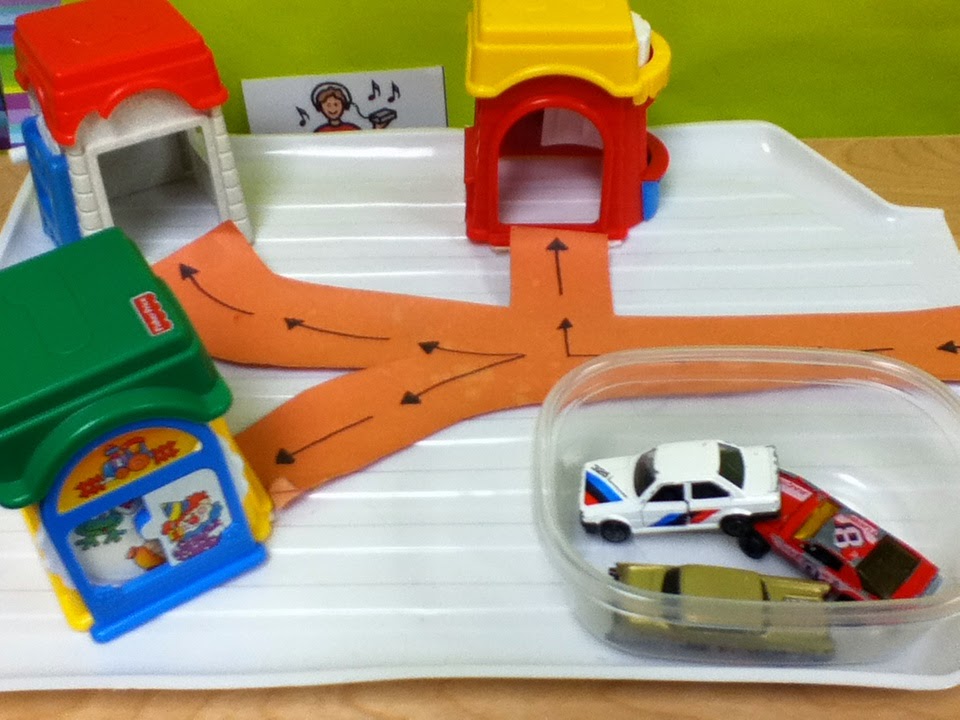What is Visual Structure?
Visual structure adds a physical or visual component to tasks to assist students in understanding HOW an activity should be completed. Because students with ASD are less likely to be successful with only verbal directions, visual structure adds a tangible component to an activity to increase meaning and understanding. Visual structure also helps a student increase attention, engagement with materials, and allows students to locate the most relevant information while completing his/her work.Visual structure has three components:
Visual Instructions: Tells the student where to begin and the sequence of steps to complete an activity
Visual Organization: How the space and materials are limited and/or arranged
Visual Clarity: Emphasizes or draws attention to important or relevant information
Why do I use Visual Structure with Students with ASD?
Engagement of students with ASD is less likely unless careful planning in the design of educational materials and activities occurs. Traditional teaching procedures and resources, such as group lessons and worksheets, may not be appealing or easy to understand for students with ASD.There is substantial evidence that students with ASD have strengths in processing visual information in comparison to processing language or auditory information. When instructions related to a task or assignment are given verbally, students with ASD may have difficulty understanding and responding quickly and appropriately. Providing the information visually, embedded within the activity, instead allows students to continually refer to instructions and have a clearer understanding of what is expected. Providing information visually capitalizes on the strengths of students and provides more opportunities for the student to practice the skill independently (without relying on verbal directives from staff).
Students with ASD may have greater difficulty in organizing and sequencing materials due to deficits in executive functioning and/or challenges in modulating sensory input. Worksheets with a great deal of information, or large quantities of materials that may fall or become mixed together may be distracting or overwhelming for students. It is often necessary for staff members to assist in organizing materials, and to present them in a minimally stimulating manner. The placement of materials in containers, folders, baskets, or trays may be beneficial. Limiting the amount of information and size of the work space to reduce stimulation may also be helpful.
Students with ASD may also have difficulty interpreting the importance of information and give undue attention to details. It may be necessary to emphasize the most important aspects of the task or activity in an effort to make the meaning more salient. This may require the use of color coding, numbering, highlighting, or adding additional visual cues.
Along with visual structure, incorporating the unique interests of students with ASD into the content and/or layout of instructional activities is another strategy to increase both engagement and meaning. Capitalizing on student interests can provide motivation to complete activities, and students may find the activities more reinforcing than traditional social reinforcement from staff members or peers.
How Do I Implement Visual Structure?
When designing activities for students with autism it is important to first consider how instructions will be provided. It is essential to supplement verbal directions with visual information. This allows students to function more independently, as they can be taught to look to the materials for information, rather than relying solely on a staff member to guide the student through the task. Supplementing instructions with visuals also helps to teach students that materials can be used for multiple purposes. For example, students can learn through visual instructions that the small colored bears can be used sometimes for sorting colors, other times for patterning, and another time for counting. Visual instructions can be provided in a variety of ways depending on what the needs of the student are and the student’s level of functioning. For the most concrete learners, the materials themselves provide the instruction information, and for students who understand pictures/words, those abstract systems can provide instructions.
For Example:
 |
| The materials define the task in this sorting activity. |
 |
| A jig or product sample tells the student what the finished product should look like. |
 |
Organization of a reading activity: materials are self-contained in a book (extra flap added to the book for pieces); work space is defined; all materials are stabilized.
|
 |
Clarifying where the student response should go: the black box indicates where the student should put his/her answer.
|
Finally, when designing teaching materials for your students with ASD, it is helpful to include student interest to increase meaning and motivation. It may not be feasible to incorporate student interest in every activity, however, designing a number of highly motivating tasks to intersperse in a work session may assist students in starting their work more successfully and in maintaining on-task behavior throughout.
 |
| A writing task using lego structures the student built. |
 |
| Sequencing the days of the week with the Hungry Caterpillar. |
 |
| A counting worksheet with Angry Birds. |
Tips for Implementing Visual Structure:
Think about how materials can be used across curricular areas or for more than one purpose to ensure the most use.
Think creatively about how activities can be made. Use volunteers or student helpers
Consider how you might share resources with other teachers or create an activity lending library in your school.
Instructional activities should relate to your individual assessments of student needs and the curriculum used by your school board.
How do you use visual structure in your classroom? I'd love to hear your ideas! Leave me a comment below!
Thanks for stopping by!




I love the idea of the play task idea. I need to do this one of my little ones. This would help him a lot! Thanks for sharing!
ReplyDeleteKate
Fun in ECSE